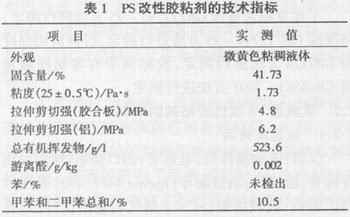3 Results and Discussion
3.1 Results and discussion of solvent-based PS modified adhesives
3.1.1 The technical properties of the PS modified adhesive produced are shown in Table 1.

3.1.2 Selection of Solvents
Styrofoam is soluble in aromatic hydrocarbons (such as benzene, toluene, xylene, etc.), chlorinated hydrocarbons (such as chloroform, trichloroethylene), carboxylic acid esters (such as ethyl acetate, butyl acetate), and ketones (such as Acetone, butanone, etc. in most organic solvents. Choosing the right solvent for dissolving the foamed plastic mainly considers the following aspects: First, the selected solvent should have good dissolving power for polystyrene and the newly added modifier, and have good dispersion performance for the added material; secondly The nature of the solvent is best to improve the properties of the adhesive. Third, the selected solvent should be low-toxic, inexpensive, accessible, and safe. Taking all these factors into consideration, it is appropriate to use ethyl acetate or toluene as a solvent. However, considering that the solubility of the mixed solvent is better than that of a single solvent, and because the boiling point, volatility, and polarity are different, by changing the mixing ratio, the drying time of the adhesive can be adjusted to meet the needs of different occasions. Therefore, ethyl acetate is selected. Both toluene and toluene were mixed as a solvent for polystyrene foam. The physicochemical parameters of these two solvents are shown in Table 2.

The solubility parameter of polystyrene is 9.11
3.1.3 Selection of solvent ratio
Ethyl acetate and toluene are used as a mixed solvent. Ethyl acetate contains polar groups, which are helpful for the improvement of the adhesive properties. It has a low boiling point and quick volatilization. Toluene is a non-polar substance with a high boiling point and a slow volatilization. The proportion of different people will influence the drying speed and adhesive force of the modified PS glue, so it is necessary to choose a more appropriate solvent ratio.

As can be seen from the figure, with the increase of the solvent ratio, that is, when the proportion of ethyl acetate increases, the shear strength of the modified liquid increases, and after the solvent ratio is 4:1, it decreases again. The reason may be due to the greater polarity of ethyl acetate, on the one hand to give a modification effect, on the other hand, can form an intermolecular interaction force with the surface of the material to be adhered, and therefore, increase the shear strength; And it volatilizes faster, just to meet the epoxy resin curing residual solvent less, and increase the shear strength requirements. Therefore, its proportion increases and the glue strength increases. However, when the proportion of ethyl acetate is too large, since it has a low boiling point and volatilizes rapidly, the internal solvent may remain in a liquid state or a semi-solid state for a long time after the adhesive edge is solidified, which affects the bonding effect and slightly lowers the shear strength.
3.1.4 Effect of Modifier Toluene Diisocyanate on Shear Strength of Adhesive
Toluene diisocyanate is a very polar substance, its modification effect is extremely obvious, only a very small amount can significantly improve the performance of the adhesive. It not only has a good modification effect on polystyrene, but also has a Very good modification effect. In the modification of waste polystyrene, there are two effects of the modifier TDI: one is the introduction of polar groups in the polystyrene macromolecules to crosslink the macromolecule chains of the polystyrene, and the second is the epoxy. The resin reacts, modifying the epoxy resin and causing partial cross-linking of both epoxy and polystyrene. The amount of modifier TDI directly affects the properties of the modified PS adhesive. If the amount of the modifier is small, the molecular chain of the polystyrene contains less polar groups, the degree of cross-linking is insufficient, the toughness is insufficient, and the epoxy resin is insufficient. Can not be modified very well, the glue layer is more brittle; if the amount is too much, it will make the material cross-linked too much, or even form a mesh body structure, reduce the shear strength, the experiment shows that the modifier dosage is 2.0 %, the modification effect is better. Figure 2

(to be continued)
Safety Raincoat,Waterproof Raincoat,PVC Raincoat
Rain Poncho,Beach Umbrella Co., Ltd. , http://www.nsraincoat.com